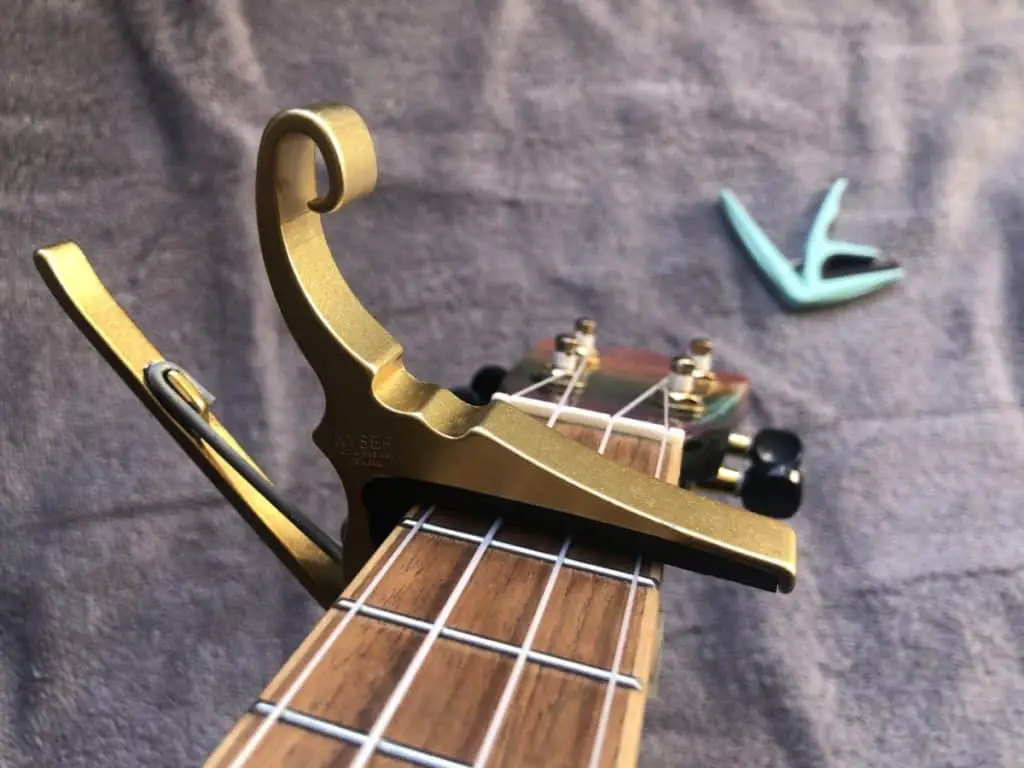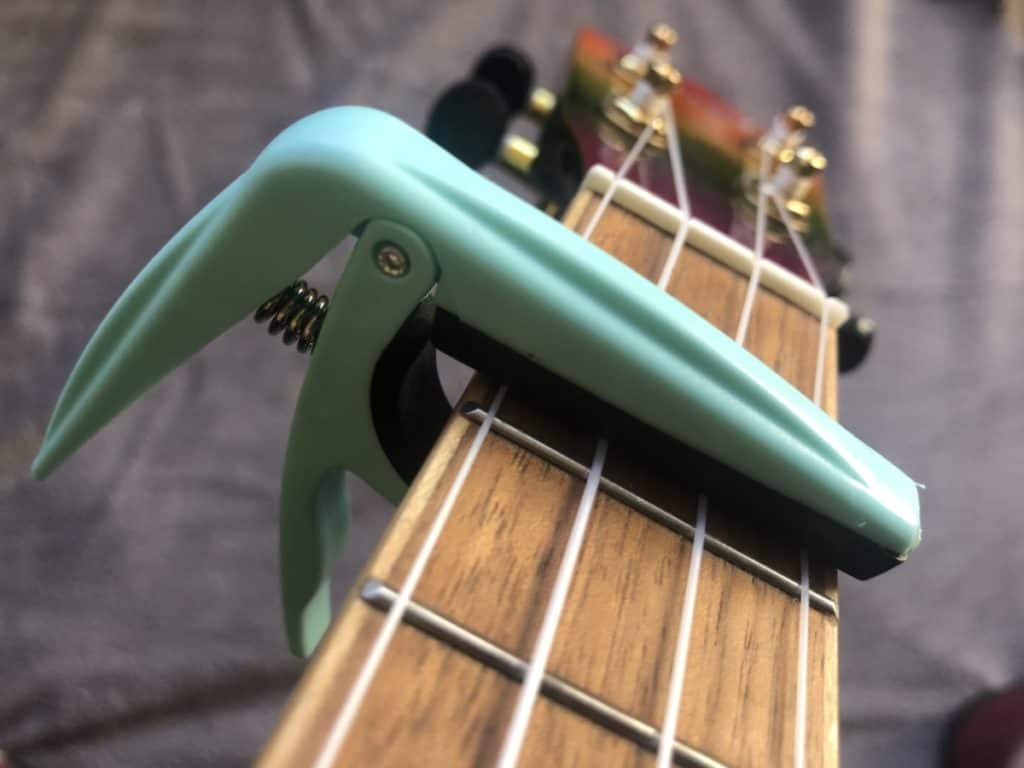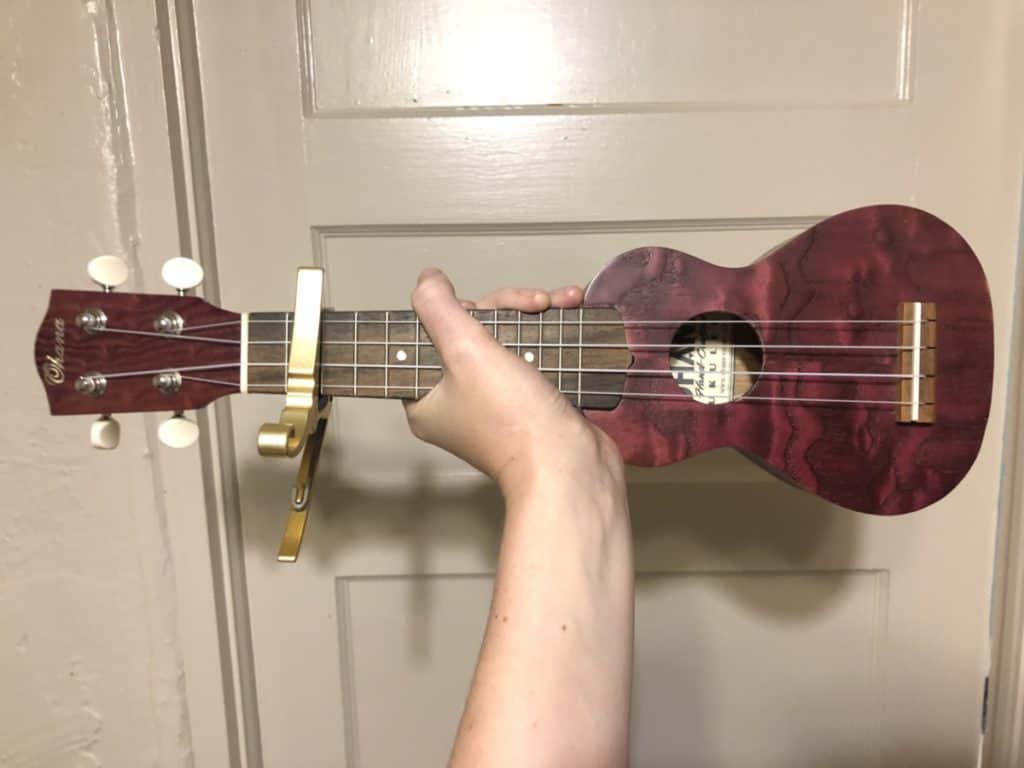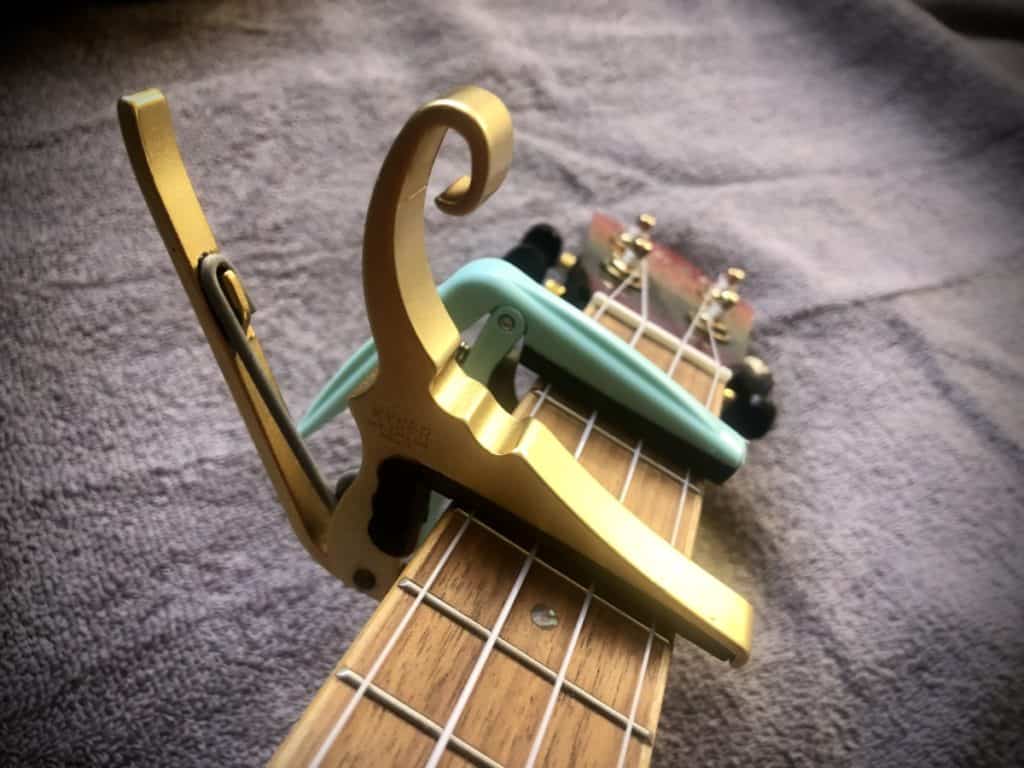Today I’m going to talk about using a guitar capo on a ukulele. I’ll explain the potential risks this poses as well as discuss the main differences between guitar and ukulele capos.
I have been playing ukulele for years and only recently started using a capo specifically made for ukuleles. Why? Because I had been using a guitar capo just fine the whole time!
While this worked for me, there are some reasons you may want to opt for a ukulele-specific capo.
Let’s dive right into a closer examination of guitar and ukulele capos.
Can You Use a Guitar Capo on a Ukulele? (Is it Safe?)
You can safely use a guitar capo on a ukulele as long as it fits on the neck. Spring and trigger style guitar capos will work best on a ukulele, but guitar capos are bigger and may make playing uncomfortable. They may also impact intonation and cause string buzz. Consider a ukulele capo for the best fit and sound.
Guitar capos are the most widely available, and therefore these are the ones many players end up buying and using. A great many ukulele players are using guitar capos on their ukes and may not even realize it!
Guitar capos apply just enough pressure to hold down the strings and feature thick rubber padding to evenly distribute the pressure and protect the fretboard and neck. For these reasons, they are safe for use on ukuleles.
However, there are a few reasons you might not want to use a guitar capo on a ukulele. Let’s take a closer look at these reasons below:
1. Player Comfort
While it is safe to use a guitar capo on a ukulele, you may experience some minor annoyances while playing. Guitar capos are designed for use on a bigger instrument with a wider and thicker neck. As a result, they are larger.
A guitar capo will stick out past the neck and take up more space in general. If you have larger hands, you may find that a guitar capo gets in your way while playing. If that’s the case, the much smaller ukulele capo is the way to go.

Capos designed for guitars are also heavier – sometimes they seem to weigh more than the ukulele! This may be noticeable during play as they will pull the neck down slightly. It’s up to you as the player if this is a deal-breaker!
By comparison, ukulele capos are smaller overall, less bulky, and weigh less.
2. Different Capo Styles
Guitar capos come in several different styles. And not all of them work on ukuleles! Pay close attention to how the capo attaches to the instrument – some of these mechanisms will not fit a ukulele.
Strap capos and toggle capos, for example, are designed to cinch a metal bar as tight as possible against the strings. This would be impossible to fit to a uke because the metal bar would be sized for a wider guitar neck and would be too long.
Other types, like adjustable screw capos and yoke capos, might attach to the ukulele but the fit would not be very good and the sound would likely be impacted.
Also, some guitar capos are designed specifically for radiused (slightly curved) fretboards on a guitar. This may result in a capo that does not press down evenly on the ukulele strings and you may notice buzzing.
The best guitar capo styles to use on a ukulele are spring capos and trigger capos. These also happen to be the least expensive and most commonly sold.

3. Sound Impact
A guitar capo will never perfectly fit a ukulele neck. While you can get away with using one, you may notice that the sound isn’t quite right.
The most common issue is buzzing on some or all of the strings. This means the capo is not pressing evenly on the fretboard. Often, you may just need to slightly readjust the capo to correct this. But sometimes it’s a sign that the capo simply does not fit the instrument.
While it might be harder to detect, an improperly fitted capo may impact your ukulele’s intonation, or, pitch accuracy.
Put simply, this means that some notes will sound “off” even though the instrument is in tune. This effect can range from barely noticeable to severe, and it’s up to you as the player what you can tolerate.
Sometimes, simply readjusting the capo will correct the issues. But if you’re having persistent problems with sound, consider buying a capo made specifically for a ukulele.

A ukulele capo is optimized to fit a smaller neck and will always be the best option for a ukulele.
4. Ukulele Size
Ukuleles come in many different sizes, ranging from miniscule pocket ukes to the almost-guitar-sized baritone ukes. Right in the middle are soprano and concert ukuleles, which are the most common sizes. Ukuleles were not created equal!
Because of this variation in neck width, it’s not really a one-size-fits all scenario for capos on ukuleles. A guitar capo might work great on a tenor ukulele but it will be rendered absurd on a pocket ukulele – and will likely make chording impossible!

The size of the ukulele you have will determine the size of capo you can use. For smaller ukes, like sopraninos and sopranos, it is best to buy a smaller ukulele-sized capo. The issues outlined above will be further exacerbated by such an extreme size difference between neck and capo.
Because the frets are closer together on smaller instruments, maneuvering around a large guitar capo may become very difficult. The uke will be neck-heavy and will not be as comfortable to hold. You may also have a harder time getting the capo adjusted to sound right.
For concert, tenor, and baritone ukes, a guitar capo will probably work just fine. These larger instruments have a lot more space to work with on the fretboard and adjustments will be easier.
Differences Between Guitar and Ukulele Capos
The basic mechanism of all capos is identical. A capo is essentially a clamp with two padded pieces that squeeze the neck to push down on the strings. It’s really the same as playing a barre chord – except it gives you a sixth finger!
The only difference between instrument-specific capos is size – specifically, the width and thickness of the instrument neck they are built for. This is why you’ll often see ukulele capos also listed as mandolin and banjo capos: they are all the same because they all fit narrow, thin necks!

Guitar capos are built to fit much larger instruments with wider necks, and are therefore bigger themselves. When used on a smaller instrument like a ukulele, the portion that clamps down on the fretboard will stick out past the neck.

Ukulele capos are made to fit the smaller neck of a uke. They are simply scaled down versions of a guitar capo. They are smaller and lighter weight overall, and the part that clamps down on the strings is shorter. This means they will not protrude past the neck.
Note: While a guitar capo can be used on a ukulele, you’d probably have a hard time getting a ukulele capo on a guitar due to its small size. It would also be too short to effectively fret all the strings.
Is a Ukulele Capo Worth it?
Capos are completely optional, but capos also make life easier, particularly if you want to experiment with playing in different keys. They are especially helpful if you enjoy singing along with your uke, as you can quickly change the key of a song to match your natural vocal range.
Once you’ve learned the basic chord shapes, a capo makes key changes a breeze. With the capo in place, you can play the same chord shapes – but they will be different chords with completely different sounds. It’s pretty magical. (And this is why they are known as “cheaters” in the banjo world!)
Of course, you can do this without a capo by learning how to transpose music – but that requires delving into the world of music theory which can be a little overwhelming at first.
Capos are relatively cheap and don’t take up much space. So why not accessorize? They are pretty fun to experiment with and can really spice up your playing. It’s almost like getting a new instrument!
Most brands now offer capos specifically made for smaller ukulele necks – and in many fun colors to boot!
Check out these options by Kyser on Amazon (FYI: we may get commissions on these at no extra cost to you. Thanks for supporting the blog!):

